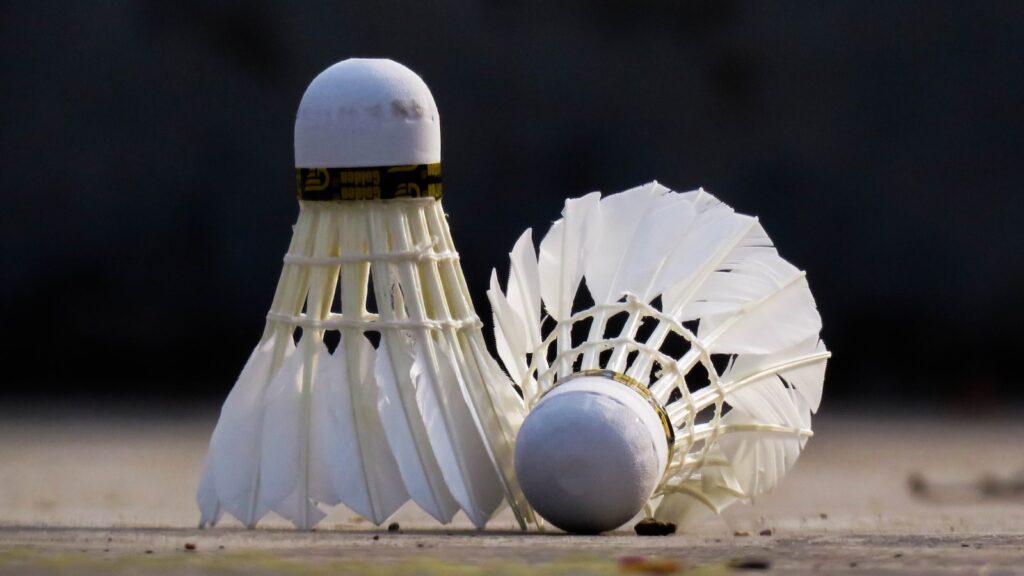Introduction
Welcome to the ultimate guide to badminton shuttlecocks! Whether you’re a professional badminton player or just starting out, understanding the importance of choosing the right shuttlecock is essential for an enjoyable and successful game. In this comprehensive guide, we will dive deep into the world of badminton shuttlecocks, exploring their design, types, and factors to consider when making a purchase. So let’s shuttle into action and explore the fascinating realm of badminton shuttlecocks. ( For more details of badminton tactics read the article Badminton tactics for single.)
Table of Contents
Badminton Shuttlecocks: An Overview

A badminton shuttlecock, also known as a birdie, is a key component of the sport of badminton. It is a cone-shaped projectile used in the game to hit back and forth between players or teams. The shuttlecock is specifically designed to provide stability, flight, and durability during gameplay.
The badminton shuttlecock is a specialized projectile used in the sport of badminton. It consists of a base, skirt, crown, and feathers, which work together to provide stability, flight, and durability. Feather shuttlecocks are preferred by professional players for their superior performance, while synthetic shuttlecocks are more commonly used for recreational play. The design and specifications of shuttlecocks are regulated by the BWF to ensure fairness and consistency in the game.
Why are Shuttlecocks Important in Badminton?
Shuttlecocks play a crucial role in determining the speed, flight, and overall performance of the game. The design and quality of a shuttlecock can significantly impact the player’s experience and the outcome of the match. Choosing the right shuttlecock suited to your playing style and environment is essential for optimal performance on the court.
Types of Badminton Shuttlecocks
When it comes to badminton shuttlecocks, there are two main types to choose from: feather shuttlecocks and synthetic shuttlecocks. Each type offers its own set of advantages and considerations. Let’s take a closer look at each:
1. Feather Shuttlecocks

Feather shuttlecocks are the traditional and preferred choice for professional players and high-level competitions. These shuttlecocks are made from the feathers of ducks or geese, carefully selected for their quality and durability. The feathers are attached to a cork base using a layer of adhesive.
Feather shuttlecocks offer excellent flight characteristics, providing precise control and a natural feel during gameplay. They are renowned for their feather-to-feather consistency, which ensures a consistent trajectory and speed. However, feather shuttlecocks are more fragile and sensitive to environmental conditions, requiring proper storage and care.
2. Synthetic Shuttlecocks-

Synthetic shuttlecocks, also known as nylon or plastic shuttlecocks, are an alternative to feather shuttlecocks. They are typically made from nylon or plastic materials, with a solid cork or foam base. Synthetic shuttlecocks are more durable and cost-effective compared to their feather counterparts.
These shuttlecocks are suitable for recreational players and beginners who are still developing their skills. They are less affected by environmental conditions, making them ideal for outdoor play. However, synthetic shuttlecocks may lack the natural flight characteristics and feel provided by feather shuttlecocks.
Factors to Consider When Choosing Shuttlecocks
Selecting the right shuttlecocks can greatly enhance your badminton experience. To make an informed decision, consider the following factors:
1. Playing Level
Your playing level is an essential factor in determining the type of shuttlecock suitable for you. Professional players and advanced enthusiasts generally prefer feather shuttlecocks for their superior performance. Recreational players and beginners may find synthetic shuttlecocks more suitable for their skill level and budget.
2. Venue
Consider where you’ll be playing badminton. If you primarily play indoors in a controlled environment, feather shuttlecocks are an excellent choice. On the other hand, if you play outdoors or in an area with variable wind conditions, synthetic shuttlecocks can withstand the elements more effectively.
3. Durability
Feather shuttlecocks tend to be more delicate and have a shorter lifespan compared to synthetic shuttlecocks. If you’re looking for longevity and value for money, synthetic shuttlecocks offer better durability.
4. Cost
The cost of shuttlecocks varies depending on the type and brand. Feather shuttlecocks are generally more expensive due to the intricate feather selection and manufacturing process. Synthetic shuttlecocks are more affordable, making them a practical choice for casual players and beginners.
5. Flight Performance
The flight performance of shuttlecocks is influenced by factors such as speed, stability, and control. Feather shuttlecocks provide superior flight characteristics and are favored by professional players for their precision and responsiveness. Synthetic shuttlecocks offer a more consistent flight, making them suitable for recreational play.
FAQs about Badminton Shuttlecocks
Now, let’s address some frequently asked questions about badminton shuttlecocks:
1. Can I use feather shuttlecocks for outdoor play?
While it is technically possible to use feather shuttlecocks outdoors, they are better suited for indoor play. Outdoor conditions, such as wind and humidity, can significantly affect the flight and durability of feather shuttlecocks. Synthetic shuttlecocks are more suitable for outdoor play.
2. How many feathers are in a feather shuttlecock?
A feather shuttlecock typically consists of 16 feathers. The feathers are strategically placed and overlap to ensure stability and flight control.
3. Are there different speeds of shuttlecocks?
Yes, shuttlecocks come at different speeds, denoted by different colors on the packaging. The colors usually represent the following speeds: slow (green), medium (blue), and fast (red). Choose the speed based on your playing level and preferences.
4. How should I store my shuttlecocks?
To maintain the quality and performance of your shuttlecocks, store them in a cool and dry place. Avoid exposing them to extreme temperatures or humidity, as these can damage the feathers or affect the flight characteristics.
5. Can I mix feather and synthetic shuttlecocks during gameplay?
While it’s generally recommended to use the same type of shuttlecocks during a match, mixing feather and synthetic shuttlecocks can be done if necessary. However, keep in mind that feather and synthetic shuttlecocks have different flight characteristics, which may impact your gameplay.
6. How often should I replace my shuttlecocks?
The frequency of shuttlecock replacement depends on factors such as the level of play, frequency of use, and type of shuttlecock. Feather shuttlecocks may need to be replaced more frequently due to their delicate nature, while synthetic shuttlecocks have a longer lifespan. Monitor the condition of your shuttlecocks and replace them when the feathers are worn or the flight is affected.
Conclusion-
In conclusion, selecting the right badminton shuttlecocks is crucial for an enjoyable and successful game. Feather shuttlecocks offer superior flight characteristics and precision, making them the preferred choice for professional players. Synthetic shuttlecocks provide durability and value for money, catering to recreational players and beginners.
Consider factors such as playing level, venue, durability, cost, and flight performance when choosing shuttlecocks. By understanding these aspects and making an informed decision, you can optimize your badminton experience and enhance your performance on the court.
So, equip yourself with the perfect shuttlecocks, grab your racquet, and get ready for an exhilarating game of badminton.










